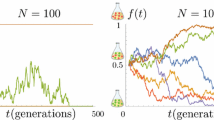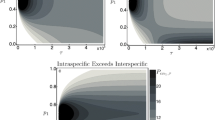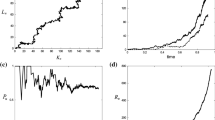Abstract
Hubbell’s neutral theory claims that ecological patterns such as species abundance distributions can be explained by a stochastic model based on simple assumptions. One of these assumptions, the point mutation assumption, states that every individual has the same probability to speciate. Etienne et al. have argued that other assumptions on the speciation process could be more realistic, for example, that every species has the same probability to speciate (Etienne, et al. in Oikos 116:241–258, 2007). They introduced a number of neutral community models with a different speciation process, and conjectured formulas for their stationary species abundance distribution. Here we study a generalised neutral community model, encompassing these modified models, and derive its stationary distribution, thus proving the conjectured formulas.
Similar content being viewed by others
References
Bell, G., 2001. Neutral macroecology. Science 293, 2413–2418.
Etienne, R.S., 2005. A new sampling formula for neutral biodiversity. Ecol. Lett. 8, 253–260.
Etienne, R.S., Alonso, D., 2007. Neutral community theory: how stochasticity and dispersal-limitation can explain species coexistence. J. Stat. Phys. 128, 485–510.
Etienne, R.S., Apol, M.E.F., Olff, H., Weissing, F.J., 2007. Modes of speciation and the neutral theory of biodiversity. Oikos 116, 241–258.
Etienne, R.S., Apol, M.E.F., 2009. Estimating speciation and extinction rates from diversity data and the fossil record. Evolution 63, 244–255.
Ewens, W.J., 1972. The sampling theory of selectively neutral alleles. Theor. Popul. Biol. 3, 87–112.
Haegeman, B., Etienne, R.S., 2008. Relaxing the zero-sum assumption in neutral biodiversity theory. J. Theor. Biol. 252, 288–294.
Hubbell, S.P., 2001. The Unified Neutral Theory of Biodiversity and Biogeography. Princeton University Press, Princeton.
Makarieva, A.M., Gorshkov, V.G., 2004. On the dependence of speciation rates on species abundance and characteristic population size. J. Biosci. 29, 119–128.
McGill, B.J., Etienne, R.S., Gray, J.S., Alonso, D., Anderson, M.J., Benecha, H.K., Dornelas, M., Enquist, B.J., Green, J., He, F., Hurlbert, A., Magurran, A.E., Marquet, P.A., Maurer, B.A., Ostling, A., Soykan, C.U., Ugland, K., White, K., 2007. Species abundance distributions: moving beyond single prediction theories to integration within an ecological framework. Ecol. Lett. 10, 995–1015.
Moran, P.A.P., 1962. Statistical Processes of Evolutionary Theory. Clarendon Press, Oxford.
Rosindell, J.L., Cornell, S.J., 2007. Species-area relationships from a spatially explicit neutral model in an infinite landscape. Ecol. Lett. 10, 586–595.
Stanley, S.M., 1975. A theory of evolution above the species level. Proc. Natl. Acad. Sci. USA 72, 646–650.
Van Kampen, N.G., 1992. Stochastic Processes in Physics and Chemistry. Elsevier, Amsterdam.
Author information
Authors and Affiliations
Corresponding author
Rights and permissions
About this article
Cite this article
Haegeman, B., Etienne, R.S. Neutral Models with Generalised Speciation. Bull. Math. Biol. 71, 1507–1519 (2009). https://doi.org/10.1007/s11538-009-9411-0
Received:
Accepted:
Published:
Issue Date:
DOI: https://doi.org/10.1007/s11538-009-9411-0




